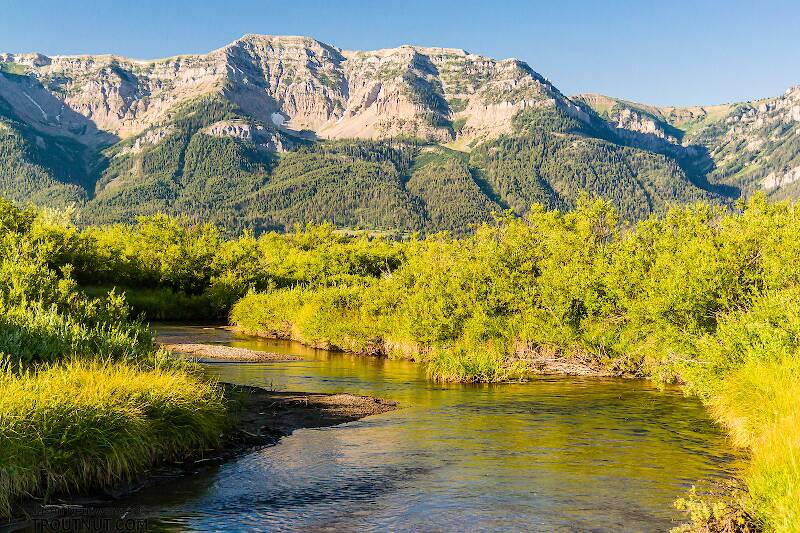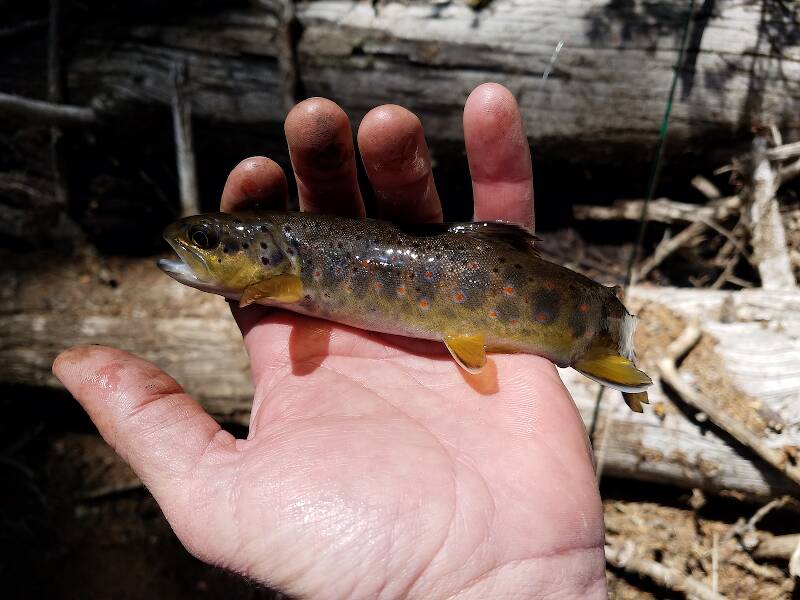
Salmonflies
Pteronarcys californica
The giant Salmonflies of the Western mountains are legendary for their proclivity to elicit consistent dry-fly action and ferocious strikes.
Featured on the forum

It's only barely visible in one of my pictures, but I confirmed under the microscope that this one has a prosternal horn and the antennae are mid-way between the eyes and front of the head capsule.
I'm calling this one Pycnopsyche, but it's a bit perplexing. It seems to key definitively to at least Couplet 8 of the Key to Genera of Limnephilidae Larvae. That narrows it down to three genera, and the case seems wrong for the other two. The case looks right for Pycnopsyche, and it fits one of the key characteristics: "Abdominal sternum II without chloride epithelium and abdominal segment IX with only single seta on each side of dorsal sclerite." However, the characteristic "metanotal sa1 sclerites not fused, although often contiguous" does not seem to fit well. Those sclerites sure look fused to me, although I can make out a thin groove in the touching halves in the anterior half under the microscope. Perhaps this is a regional variation.
The only species of Pycnopsyche documented in Washington state is Pycnopsyche guttifera, and the colors and markings around the head of this specimen seem to match very well a specimen of that species from Massachusetts on Bugguide. So I am placing it in that species for now.
Whatever species this is, I photographed another specimen of seemingly the same species from the same spot a couple months later.
I'm calling this one Pycnopsyche, but it's a bit perplexing. It seems to key definitively to at least Couplet 8 of the Key to Genera of Limnephilidae Larvae. That narrows it down to three genera, and the case seems wrong for the other two. The case looks right for Pycnopsyche, and it fits one of the key characteristics: "Abdominal sternum II without chloride epithelium and abdominal segment IX with only single seta on each side of dorsal sclerite." However, the characteristic "metanotal sa1 sclerites not fused, although often contiguous" does not seem to fit well. Those sclerites sure look fused to me, although I can make out a thin groove in the touching halves in the anterior half under the microscope. Perhaps this is a regional variation.
The only species of Pycnopsyche documented in Washington state is Pycnopsyche guttifera, and the colors and markings around the head of this specimen seem to match very well a specimen of that species from Massachusetts on Bugguide. So I am placing it in that species for now.
Whatever species this is, I photographed another specimen of seemingly the same species from the same spot a couple months later.

Troutnut is a project started in 2003 by salmonid ecologist Jason "Troutnut" Neuswanger to help anglers and
fly tyers unabashedly embrace the entomological side of the sport. Learn more about Troutnut or
support the project for an enhanced experience here.
Tor on Sep 20, 2020September 20th, 2020, 1:22 pm EDT
So I have been trout fishing for years in the Western NC mountains. Have decided to take up fly fishing for trout.
I have read up on rods /reels / flies etc. I will only be fishing (to start anyway) in the NC mountains (Davidson River, Avery Creek size rivers. My main question is fly rod weight. Would a 3-weight, say between 6,5 and t ft be appropriate for these kind of rivers? Maybe a 3-weight Echo Fly Rods River Glass Fiberglass series?
Could someone guide me in the proper direction for rod size.....we are talking 15-16 inch trout at the most.
I have read up on rods /reels / flies etc. I will only be fishing (to start anyway) in the NC mountains (Davidson River, Avery Creek size rivers. My main question is fly rod weight. Would a 3-weight, say between 6,5 and t ft be appropriate for these kind of rivers? Maybe a 3-weight Echo Fly Rods River Glass Fiberglass series?
Could someone guide me in the proper direction for rod size.....we are talking 15-16 inch trout at the most.
Partsman on Sep 21, 2020September 21st, 2020, 12:33 pm EDT
Tor, your in the ballpark with the 3 wt., 6 1/2 to 7 1/2 ft. The fiberglassflyrodders web site has many articles of fishing just those types of streams. All some excellent breakdown of rods. Good luck with your choice, lots of choices which is a good thing.
Mike.
Mike.
Troutnut on Sep 21, 2020September 21st, 2020, 1:44 pm EDT
I don't know those streams, but I was able to google a few pictures. In general when starting fly fishing it's ideal to start with something like an 8'6" 5-weight, maybe 4-weight if you're targeting smaller streams and smaller fish. That's kind of the classic "all-around" fly rod. A 6.5 to 7.5-foot fly rod is very short and typically a specialty rod for casting in tight quarters on very small streams, and it'll be harder to cast at any kind of distance or in any sort of wind under other circumstances. It's easier to use an 8'6" rod on a tight, small stream than it is to use a 7' 3-weight when something bigger is called for.
Also, I haven't fished fiberglass but my understanding is those rods generally have a pretty slow/soft action and are a bit heavier. A decent entry-level graphite rod might be better to start with, then branch out to more specialized rods once you have a feel for the kind of fly fishing you end up enjoying and what kind of rod(s) would best complement your style of fishing.
Also, I haven't fished fiberglass but my understanding is those rods generally have a pretty slow/soft action and are a bit heavier. A decent entry-level graphite rod might be better to start with, then branch out to more specialized rods once you have a feel for the kind of fly fishing you end up enjoying and what kind of rod(s) would best complement your style of fishing.
Jason Neuswanger, Ph.D.
Troutnut and salmonid ecologist
Troutnut and salmonid ecologist
Martinlf on Sep 24, 2020September 24th, 2020, 10:05 am EDT
I'd agree with Jason. An 8.5 ft 4 or 5 weight is a good rod to start out with, and it would be perfect for the Davidson, Nantahala, and many other small to medium size N.C. rivers. I typically use a 9' 3 weight on all but the smallest of the smaller streams I fish. On rivers the size of the Davidson I'd prefer a 9 or 10' rod in either a 4 or 5 weight. A glass rod may be slightly easier to learn to cast, but a medium to medium fast graphite rod may perform better under more variable conditions. I'd avoid a fast rod for now, though.
"He spread them a yard and a half. 'And every one that got away is this big.'"
--Fred Chappell
--Fred Chappell
Red_green_h on Sep 24, 2020September 24th, 2020, 12:29 pm EDT
My first rod was a 8 ft 4 wt. Still love getting it out. I can cast that sucker out almost as far as my 8'6" 5 wt after "greasing" it up with line dressing. My 1 wt rod is glass and it is definitely slow action and takes some getting used to after fishing medium/fast action. I just got my son a 7'6" 3 wt Echo base combo for his first rod/reel. Bu we fish a lot of smaller streams where we only have to cast 20 to 30 ft out if even that. It's perfect for him to learn on. I might suggest buying one of those combos. They are cheap but a pretty solid set up. Most people you talk to will suggest at least 9' rods no matter where you fish. Which is fine but fishing a shorter rod has its perks especially for beginners IMO. I would suggest staying away from glass until you are decent at casting. They tend to be more expensive and when you are first learning it can be easier to break a blank than cast your line out.
Quick Reply
Related Discussions
Topic
Replies
Last Reply
0
Jan 27, 2017
by Mcflyangler
by Mcflyangler
3
Sep 24, 2012
by Entoman
by Entoman





